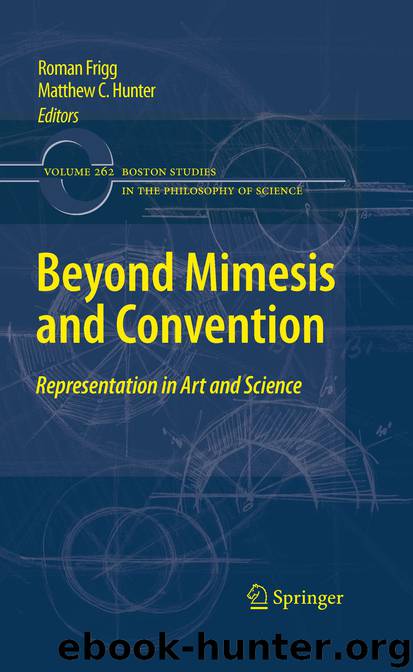Beyond Mimesis and Convention by Roman Frigg & Matthew C. Hunter

Author:Roman Frigg & Matthew C. Hunter
Language: eng
Format: epub
Publisher: Springer Netherlands, Dordrecht
A First Stab at T-Representation
So far I have argued that models are imagined objects and I have shown how this leads to a coherent overall view of scientific modeling (shown in Fig. 1). In particular, I have presented an account of what it means for claims about a model-system to be true, how we learn about model-systems, and how we can meaningfully compare them to either things in the world or other model systems. What is still missing from the analysis is an account of how model-systems represent (i.e., t-represent) something beyond themselves. The structuralist answer (that representation essentially is isomorphism) is not available to the fiction view since only structures can enter into isomorphisms and model-systems, on this view, are not structures. So we have to go back to the drawing board and develop a new account of representation that can explain how a model-system of the kind introduced in section “Model-Systems and Imagination” can represent a target system. This is project for this section.
The first question is what to choose as our source from which we might formulate an account of t-representation. So far I have developed an account of scientific modeling by drawing analogies with literary fiction. Unfortunately this analogy does not seem to be productive when it comes to t-representation. Understanding t-representation involves establishing and understanding a relation between the fictional scenario and parts (or aspects) of the real world. While we sometimes do this casually (for instance when I compare my friend James with Zapp), there is controversy over whether this is in any way essential to our engagement with fiction, and whether it leads to any interesting insights. Elgin (1996, Chapter 6) argues it does, which is what Kivy (2006, Chapters 24 –28) denies. But even if this controversy could be resolved in favor of those who believe in the cognitive value of literature, there is no general method of bringing to bear literary fictions on real-world situations, which could serve as the blue-print for t-representation in science.40
The analogy I wish to exploit in what follows is the one between maps and scientific representations. This analogy is of course not new; see Sismondo and Chrisman (2001) for a survey and discussion. But I want to put the analogy to a slightly different use than other writers. While the map analogy has in the past mainly been employed to defend some sort of scientific realism, I wish to remain non-committal about realism and use maps only to explain how representation works at the most general level.41 42
The essence of a map is that it allows us to “read off” properties of the territory from the map: by looking at a map of London we see that Camden lies west of Hackney, Brixton is south of the river, etc. The map is different from a verbal description in that it does not merely state these facts; maps are not long lists with sentences describing a certain area. Facts about the city are inferred from facts about
Download
This site does not store any files on its server. We only index and link to content provided by other sites. Please contact the content providers to delete copyright contents if any and email us, we'll remove relevant links or contents immediately.
| Anthropology | Archaeology |
| Philosophy | Politics & Government |
| Social Sciences | Sociology |
| Women's Studies |
The remains of the day by Kazuo Ishiguro(8819)
Tools of Titans by Timothy Ferriss(8218)
Giovanni's Room by James Baldwin(7189)
The Black Swan by Nassim Nicholas Taleb(7010)
Inner Engineering: A Yogi's Guide to Joy by Sadhguru(6725)
The Way of Zen by Alan W. Watts(6505)
Asking the Right Questions: A Guide to Critical Thinking by M. Neil Browne & Stuart M. Keeley(5632)
The Power of Now: A Guide to Spiritual Enlightenment by Eckhart Tolle(5605)
The Six Wives Of Henry VIII (WOMEN IN HISTORY) by Fraser Antonia(5394)
Astrophysics for People in a Hurry by Neil DeGrasse Tyson(5130)
Housekeeping by Marilynne Robinson(4344)
12 Rules for Life by Jordan B. Peterson(4249)
Double Down (Diary of a Wimpy Kid Book 11) by Jeff Kinney(4207)
The Ethical Slut by Janet W. Hardy(4173)
Skin in the Game by Nassim Nicholas Taleb(4162)
Ikigai by Héctor García & Francesc Miralles(4125)
The Art of Happiness by The Dalai Lama(4063)
Skin in the Game: Hidden Asymmetries in Daily Life by Nassim Nicholas Taleb(3929)
Walking by Henry David Thoreau(3893)
